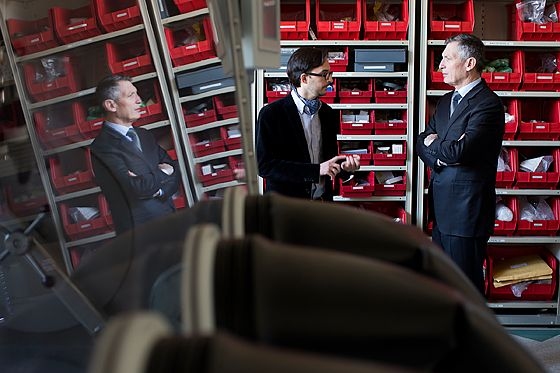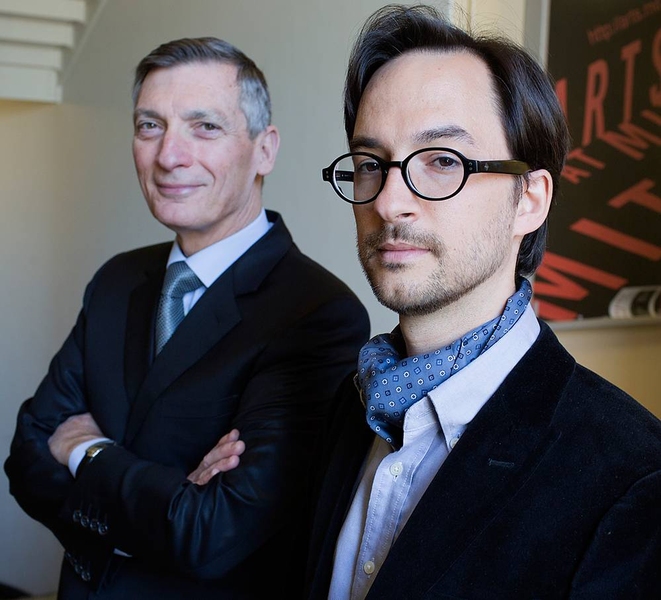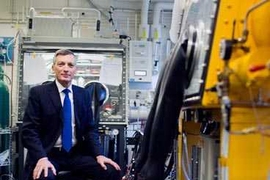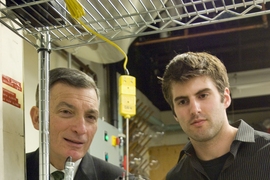Anyone who has seen pictures of the giant, red-hot cauldrons in which steel is made — fed by vast amounts of carbon, and belching flame and smoke — would not be surprised to learn that steelmaking is one of the world’s leading industrial sources of greenhouse gases. But remarkably, a new process developed by MIT researchers could change all that.
The new process even carries a couple of nice side benefits: The resulting steel should be of higher purity, and eventually, once the process is scaled up, cheaper. Donald Sadoway, the John F. Elliott Professor of Materials Chemistry at MIT and senior author of a new paper describing the process, says this could be a significant “win, win, win” proposition.
The paper, co-authored by Antoine Allanore, the Thomas B. King Assistant Professor of Metallurgy at MIT, and former postdoc Lan Yin (now a postdoc at the University of Illinois at Urbana-Champaign), has just been published in the journal Nature.
Worldwide steel production currently totals about 1.5 billion tons per year. The prevailing process makes steel from iron ore — which is mostly iron oxide — by heating it with carbon; the process forms carbon dioxide as a byproduct. Production of a ton of steel generates almost two tons of CO2 emissions, according to steel industry figures, accounting for as much as 5 percent of the world’s total greenhouse-gas emissions.
The industry has met little success in its search for carbon-free methods of manufacturing steel. The idea for the new method, Sadoway says, arose when he received a grant from NASA to look for ways of producing oxygen on the moon — a key step toward future lunar bases.
Sadoway found that a process called molten oxide electrolysis could use iron oxide from the lunar soil to make oxygen in abundance, with no special chemistry. He tested the process using lunar-like soil from Meteor Crater in Arizona — which contains iron oxide from an asteroid impact thousands of years ago — finding that it produced steel as a byproduct.
Sadoway’s method used an iridium anode, but since iridium is expensive and supplies are limited, that’s not a viable approach for bulk steel production on Earth. But after more research and input from Allanore, the MIT team identified an inexpensive metal alloy that can replace the iridium anode in molten oxide electrolysis.
It wasn’t an easy problem to solve, Sadoway explains, because a vat of molten iron oxide, which must be kept at about 1600 degrees Celsius, “is a really challenging environment. The melt is extremely aggressive. Oxygen is quick to attack the metal.”

Many researchers had tried to use ceramics, but these are brittle and can shatter easily. “I had always eschewed that approach,” Sadoway says.
But Allanore adds, “There are only two classes of materials that can sustain these high temperatures — metals or ceramics.” Only a few metals remain solid at these high temperatures, so “that narrows the number of candidates,” he says.
Allanore, who worked in the steel industry before joining MIT, says progress has been slow both because experiments are difficult at these high temperatures, and also because the relevant expertise tends to be scattered across disciplines. “Electrochemistry is a multidisciplinary problem, involving chemical, electrical and materials engineering,” he says.
The problem was solved using an alloy that naturally forms a thin film of metallic oxide on its surface: thick enough to prevent further attack by oxygen, but thin enough for electric current to flow freely through it. The answer turned out to be an alloy of chromium and iron — constituents that are “abundant and cheap,” Sadoway says.
In addition to producing no emissions other than pure oxygen, the process lends itself to smaller-scale factories: Conventional steel plants are only economical if they can produce millions of tons of steel per year, but this new process could be viable for production of a few hundred thousand tons per year, he says.
Apart from eliminating the emissions, the process yields metal of exceptional purity, Sadoway says. What’s more, it could also be adapted to carbon-free production of metals and alloys including nickel, titanium and ferromanganese, with similar advantages.
Ken Mills, a visiting professor of materials at Imperial College, London, says the approach outlined in this paper “seems very sound to me,” but he cautions that unless legislation requires the industry to account for its greenhouse-gas production, it’s unclear whether the new technique would be cost-competitive. Nevertheless, he says, it “should be followed up, as the authors suggest, with experiments using a more industrial configuration.”
Sadoway, Allanore and a former student have formed a company to develop the concept, which is still at the laboratory scale, to a commercially viable prototype electrolysis cell. They expect it could take about three years to design, build and test such a reactor.
The research was supported by the American Iron and Steel Institute and the U.S. Department of Energy.








